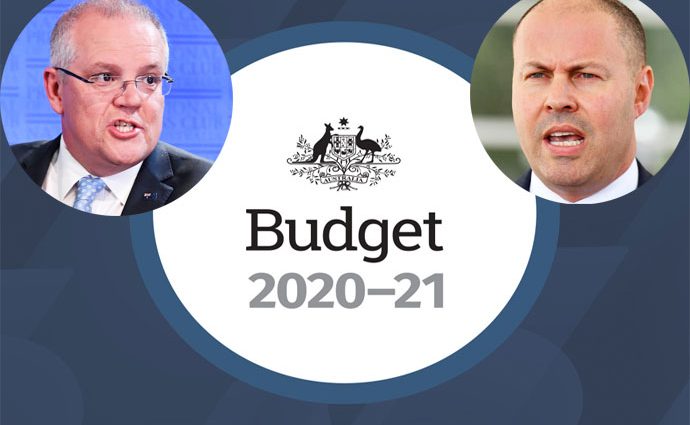Once the COVID-19 pandemic hit Australia and brought its economy on its knees, there was only one option for the government – to spend and spend to hold the economy from totally collapsing while the world finds a vaccine for the virus. The fiscal prudence rule books are not for pandemics and the Morrison-Frydenberg duo knew it pretty well and so did their critics. Federal Budget 2020 reflects that.
The budget was postponed from April to October and the various packages of JobKeeper, JobSeeker, HomeBuilder and JobMaker and the like were introduced progressively to give hope and comfort to Australians – who it is more or less accepted value what the government has done for them while the situation in many other countries has been a lot worse.
No wonder then – the only mantra in the budget (announced yesterday) could have been – “reconstruction” of the economy – which can only start with creating jobs. For a layman the headline figure of $213.7 billion deficit for 2020-21—representing 11.0% of GDP – and the increase in net debt to 43.8% of GDP by 2023-24 will perhaps make little sense. For the Aussie battler, some kind of job will do.
Jobs
No wonder then we are told that this budget is about jobs, jobs, jobs. And on Treasury’s advice Josh Frydenberg forecasts “nearly a million” of them.
The big-ticket item in this budget is a ‘JobMaker hiring credit’. Under this scheme businesses (escept banks) that hire people for at least 20 hours a week, under age 35 who are currently on JobSeeker will get up to $200 per employee per week.
The scheme is forecast to support 450,000 jobs, at a cost of $4 billion.
Other measures to create jobs are low- and middle-income tax cuts (50,000 jobs), wage subsidy for apprentices and trainees (100,000) and spending on business infrastructure, including providing instant asset write-offs for any purchase made by firms with up to $5 billion turnover (50,000).
In addition to these, a further 40,000 jobs are said to be supported by record infrastructure spending, and another 10,000 through a new recycling initiative.
Critics of the government say, most of these estimates are based on assumption of finding a vaccine by the end of 2021, giving hope to businesses to continue to invest to operate and grow in order for the jobs to be created and sustained. The criticism may be right but there is no alternative for the government but to focus on jobs and target areas where it can see jobs can be created.
No wonder spending has rocketed up to $677.4 billion for 2020-21, compared to a projection of $514.5 billion for that period at the last budget.
The “Tax cuts”
The much hyped bringing forward the already-legislated “phase 2” and “phase 3” personal income tax cuts, due to begin on July 1 2022 and July 1 2024, respectively will deliver some benefits. Whether people spend or save will again depend on the vaccine progress.
Phase 2, will raise the income threshold for the 37% marginal rate from $90,000 to $120,000. It has been brought forward to this fiscal year. Phase 3, which abolishes the 37% bracket altogether, applying the top marginal rate of 45% to a new $200,000 threshold does not kick in until 2024, as scheduled.
For people living off their weekly/fortnightly pay packets, this is all theoretical. And they are the ones who will spend all the money if and when they are given. This group is only 2.7%.
And the group of large Australians just below the top size of pay packet – is large in number and they will way up the options and are also likely to spend rather than hoard it as their total financial worth (including their real estate) offers them security and propensity to spend.
Thus the case for tax cuts – in the current clime, does make fiscal sense.
Tax relief by taxable income, 2020–21 compared with 2017–18
| 2017–18 | 2020–21 | ||||
| Taxable Income ($) | Tax Liability ($) (2017-18) |
Tax Liability ($) (2020-21) |
Change in Tax ($) | Change in Tax (%) | |
| 40,000 | 4,947 | 3,887 | -1,060 | -21.4 | |
| 60,000 | 12,147 | 9,987 | -2,160 | -17.8 | |
|
80,000 |
19,147 | 16,987 | -2,160 |
-11.3 |
|
| 100,000 | 26,632 | 24,187 | -2,445 | -9.2 | |
| 120,000 | 34,432 | 31,687 | -2,745 | -8.0 | |
| 140,000 | 42,232 | 39,667 | -2,565 | -6.1 | |
| 160,000 | 50,032 | 47,467 | -2,565 | -5.1 | |
|
180,000 |
57,832 | 55,267 | -2,565 |
-4.4 |
|
| 200,000 | 67,232 | 64,667 | -2,565 |
-3.8 |
|
The above table from the Budget Papers shows those earning $40,000 a year will pay $1,060 less tax this year than what they paid in the 2018 fiscal year. Those earning $60,000 will pay $2,160 less, and those earning $100,000 and above will pay around $2,500 less.
Welfare
Federal budget 2020 makes no changes to JobSeeker welfare program which is –due to revert to its pre-pandemic rate of $40 a day once the Coronavirus Supplement and ends on December 31.
People on the age pension, disability support pension, carer payment and carer allowance and other welfare payments, will receive two $250 payments, one in November and another in “early 2021”.
Aged care
With COVID-19 casualties in aged care, the government in the Federal Budget 2020 has announced 23,000 new home care packages at a cost $1.6 billion. This will allow older people nationwide to stay in their house instead of having to move into nursing homes.
An amount of $30 million has been allocated for a serious incident response centre and to implement recommendations of the Royal Commission.
Similar Posts by The Author:
- To save the Labor party’s chances, it is imperative Anthony Albanese exits
- Has Justin Trudeau sunk India-Canada bilateral relations to the point of ‘beyond repair’?
- Fatima Payman’s ‘Australia’s Voice’ – Lessons from Kaushaliya Vaghela’s Vic Labor stint
- Haryana puts Rahul Gandhi back in the box
- Dr TJ Rao OAM, a legend will live on

